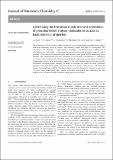Correlating the transition dipole moment orientation of phosphorescent emitter molecules in OLEDs with basic material properties
Abstract
The orientation of the emissive dipole moment of seven iridium-based phosphorescent emitter molecules commonly used in organic light-emitting diodes (OLEDs) is investigated. The orientation of Ir(ppy)3, Ir(ppy)2(acac), Ir(chpy)3, Ir(dhfpy)2(acac), Ir(BT)2(acac), Ir(MDQ)2(acac), and Ir(piq)3 is determined by measuring the angle dependent spectral radiant intensity of the transverse magnetic polarized emission from p–i–n OLEDs comprising these emitters. The experimental data are compared to the intensity calculated by a multilayer simulation method that includes the anisotropy factor describing the average dipole orientation. Surprisingly, among these molecules, Ir(ppy)3 is the only emitter showing an isotropically distributed transition dipole moment. In order to correlate our results with basic molecular properties, the permanent dipole moment and the size of the molecules are calculated by density functional theory (DFT). The dipole–dipole potential obtained for Ir(ppy)3 is more than 2.5 times larger than those for all other emitter molecules investigated here, indicating that this parameter is correlated with the transition dipole moment orientation.
Citation
Graf , A , Liehm , P , Murawski , C , Hofmann , S , Leo , K & Gather , M C 2014 , ' Correlating the transition dipole moment orientation of phosphorescent emitter molecules in OLEDs with basic material properties ' , Journal of Materials Chemistry C , vol. Early online . https://doi.org/10.1039/C4TC00997E
Publication
Journal of Materials Chemistry C
Status
Peer reviewed
ISSN
2050-7526Type
Journal article
Description
This work received funding from the ESF/EU project OrganoMechanics and the European Community's Seventh Framework Programme under Grant Agreement no. FP7 267995 (NUDEV)Collections
Items in the St Andrews Research Repository are protected by copyright, with all rights reserved, unless otherwise indicated.

